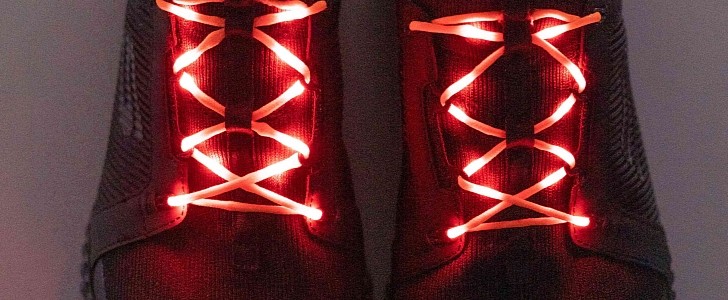Cyclists of the world (and joggers, and riders of other types of two-wheelers): scientists are looking out for you, trying to find ways to make your life better by keeping you safer in traffic.
One such group of scientists is the ATRG (Advanced Textiles Research Group), founded by Professor Tilak Dias in 2010 at Nottingham Trent University. They have developed light-up laces specifically for joggers and cyclists, with the goal of making them more visible in traffic at nighttime.
The shoelaces contain hidden LEDs “the size of a flea” that can be switched on by clicking the heels together, much like Dorothy did to get back to Kansas. They don’t have magical powers, though; instead, they flash to make the wearer more visible in traffic. The LEDs are covered in waterproof resin, which means the shoelaces can be washed and worn several times, like regular shoelaces.
Power for the LEDs comes from a small battery integrated in the shoe. Electronics linked to the on/off sensor are also incorporated in the shoe design, in a small silicone pod that protects them from the elements. According to researchers, this small pod is “barely felt” by the wearer.
Aside from the benefits in terms of safety, these shoelaces also have serious potential of becoming a fashionable accessory. Think of children’s light-up shoewear, but for grown-ups. And somewhat less fun.
“These laces could become a very simply way for runners or cyclists to improve their visibility on dark winter nights,” Professor Tilak Dias explains to Innovation in Textiles. “Not only that, but our contacts in industry believe that they could become popular as a fashion accessory and worn for aesthetic purposes, as well as safety reasons.”
“This technology shows how smart textiles can improve safety for athletes, but also how it can be used as a fashion accessory,” Dr Theodore Hughes-Riley of the ATRG adds. “This technology could become very appealing to the market soon, as our research into optimizing the smart textiles manufacturing process will enable industry to take a huge step forward to producing these kinds of electronic textiles for the consumer.”
The shoelaces contain hidden LEDs “the size of a flea” that can be switched on by clicking the heels together, much like Dorothy did to get back to Kansas. They don’t have magical powers, though; instead, they flash to make the wearer more visible in traffic. The LEDs are covered in waterproof resin, which means the shoelaces can be washed and worn several times, like regular shoelaces.
Power for the LEDs comes from a small battery integrated in the shoe. Electronics linked to the on/off sensor are also incorporated in the shoe design, in a small silicone pod that protects them from the elements. According to researchers, this small pod is “barely felt” by the wearer.
Aside from the benefits in terms of safety, these shoelaces also have serious potential of becoming a fashionable accessory. Think of children’s light-up shoewear, but for grown-ups. And somewhat less fun.
“These laces could become a very simply way for runners or cyclists to improve their visibility on dark winter nights,” Professor Tilak Dias explains to Innovation in Textiles. “Not only that, but our contacts in industry believe that they could become popular as a fashion accessory and worn for aesthetic purposes, as well as safety reasons.”
“This technology shows how smart textiles can improve safety for athletes, but also how it can be used as a fashion accessory,” Dr Theodore Hughes-Riley of the ATRG adds. “This technology could become very appealing to the market soon, as our research into optimizing the smart textiles manufacturing process will enable industry to take a huge step forward to producing these kinds of electronic textiles for the consumer.”



